英语词汇学总结复习资料
英语词汇学知识点整理
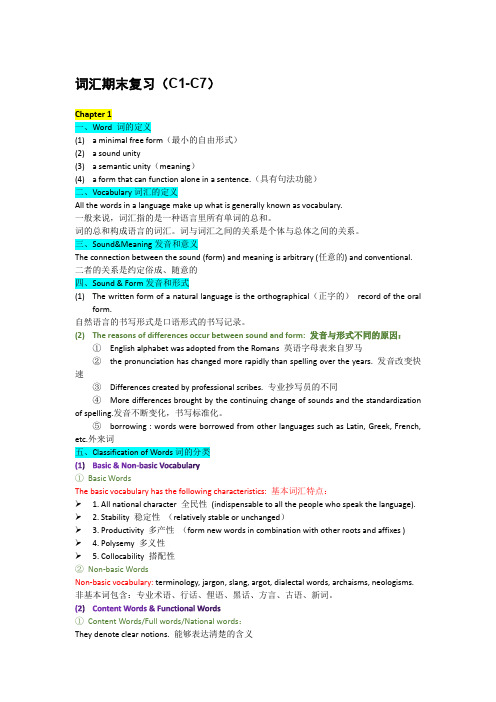
词汇期末复习(C1-C7)Chapter 1一、Word 词的定义(1) a minimal free form(最小的自由形式)(2) a sound unity(3) a semantic unity(meaning)(4) a form that can function alone in a sentence.(具有句法功能)二、Vocabulary词汇的定义All the words in a language make up what is generally known as vocabulary.一般来说,词汇指的是一种语言里所有单词的总和。
词的总和构成语言的词汇。
词与词汇之间的关系是个体与总体之间的关系。
三、Sound&Meaning发音和意义The connection between the sound (form) and meaning is arbitrary (任意的) and conventional. 二者的关系是约定俗成、随意的四、Sound & Form发音和形式(1)The written form of a natural language is the orthographical(正字的)record of the oralform.自然语言的书写形式是口语形式的书写记录。
(2)The reasons of differences occur between sound and form: 发音与形式不同的原因:①English alphabet was adopted from the Romans 英语字母表来自罗马②the pronunciation has changed more rapidly than spelling over the years. 发音改变快速③Differences created by professional scribes. 专业抄写员的不同④More differences brought by the continuing change of sounds and the standardization of spelling.发音不断变化,书写标准化。
《英语词汇学 》复习资料
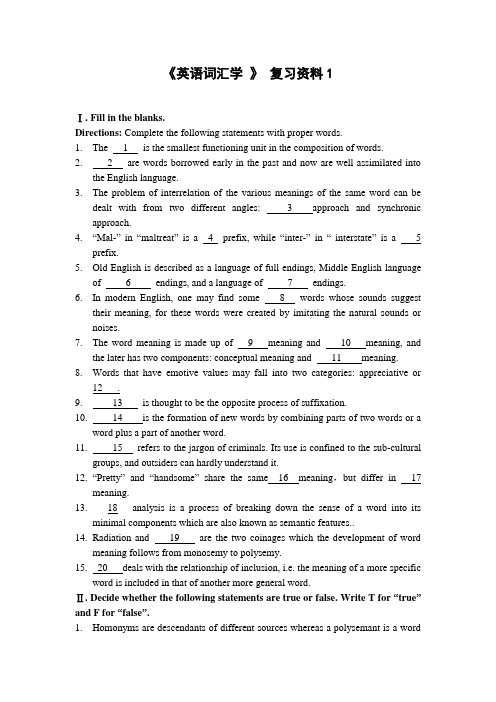
《英语词汇学》复习资料1Ⅰ. Fill in the blanks.Directions: Complete the following statements with proper words.1.The 1 is the smallest functioning unit in the composition of words.2. 2 are words borrowed early in the past and now are well assimilated intothe English language.3.The problem of interrelation of the various meanings of the same word can bedealt with from two different angles: 3 approach and synchronic approach.4.“Mal-”in “maltreat”is a 4 prefix, while “inter-”in “interstate”is a 5prefix.5.Old English is described as a language of full endings, Middle English languageof 6 endings, and a language of 7 endings.6.In modern English, one may find some 8 words whose sounds suggesttheir meaning, for these words were created by imitating the natural sounds or noises.7.The word meaning is made up of 9 meaning and 10 meaning, andthe later has two components: conceptual meaning and 11 meaning.8.Words that have emotive values may fall into two categories: appreciative or12 .9.13 is thought to be the opposite process of suffixation.10.14 is the formation of new words by combining parts of two words or aword plus a part of another word.11.15 refers to the jargon of criminals. Its use is confined to the sub-culturalgroups, and outsiders can hardly understand it.12.“Pretty”and “handsome”share the same 16 meaning,but differ in 17meaning.13.___18___analysis is a process of breaking down the sense of a word into itsminimal components which are also known as semantic features..14.Radiation and 19 are the two coinages which the development of wordmeaning follows from monosemy to polysemy.15.20 deals with the relationship of inclusion, i.e. the meaning of a more specificword is included in that of another more general word.Ⅱ. Decide whether the following statements are true or false. Write T for “true”and F for “false”.1.Homonyms are descendants of different sources whereas a polysemant is a wordof the same source which has acquired different meanings in the course of development.2.Words of the basic word stock are mostly root words or monosyllabic words, sothey have strong productivity.3.“Can-opener” used as slang to mean “all-purpose key”.4.Native words are neutral in style.5.The Indo-European language family is made up of most languages of Europe, theFar East, and India.6.Borrowing has played a vital role in the development of English vocabulary,particularly in earlier times.7.The smallest functioning unit in the composition of words is morpheme.8.Stem is a form to which affixes of any kind can be added.9.Base is what remains of a word after the removal of all affixes.10.Words created by compounding occupy the highest percentage of the Englishvocabulary.11.“Fore-”in “forehead”and “fore-”in “foreknowledge”belong to two kinds ofprefix.12.Word-building and word-formation are relative synonyms.13.The word manusc ript which originally denotes “handwriting” only has undergonea process of extension of meaning.14.Parent—child and husband—wife are two pairs of converses.15.Policeman, constable, bobby and cop are synonyms differing in intensity.Ⅲ. Answer the following questions briefly.1.What are the characteristics of the basic word stock?2.Why are prefixes and suffixes divided according to different criteria?3.List the four sources of synonyms.4.What are the characteristics of conceptual meaning and associative meaning? Ⅳ. Answer the following questions according to the requirement.Classify the three pairs of antonyms according to types of antonyms you have learned and describe the characteristics of each type of them.interviewer/interviewee; male/female; old /young成考复习资料答案I.Fill in the blanks.1. morpheme2. denizens3. diachronic4. pejorative5. locative6. leveled7. lost8. onomatopoeic9. grammatical10. lexical11.associative 12. pejorative 13. backformation 14. blending15. argot 16. conceptual 17. collocative 18. componential 19.concatenation 20. hyponymyII.Decide whether the following statements are true or false. Write T for “true” and F for “false”.1-5 TTTFT 6-10 TFFFT 11-15 TFFTFIII.Answer the following questions briefly.1.What are the characteristics of the basic word stock?1)All national character 2) stability 3) productivity 4) polysemy5) collocability2.Why are prefixes and suffixes divided according to different criteria?1)Prefixes primarily effect a semantic modification of the base, i.e. prefixes do notgenerally change the word-class of the base but only modify its meaning.2)Suffixes have only a small semantic role and their primary function is to changethe grammatical function of the base, i.e. the change of the word class with a slight modification of meaning.3)So prefixes are categorized on a semantic basis while suffixes are divided on agrammatical basis.3.1)Borrowing; (2) dialects and regional English (3) figurative and euphemisticuse of words (4) coincidence with idiomatic expressions4.What are the characteristics of conceptual meaning and associative meaning?1)Conceptual meaning is the meaning given in the dictionary and forms thecore of word meaning. Being constant and relatively stable, conceptualmeaning forms the basis for communication as the same word generallyhas the same conceptual meaning to the speakers in the same speechcommunity. (3%)2)Associative meaning differs from the conceptual meaning in that it isopen-ended and indeterminate, liable to the influence of such factors asculture, experience, religion, geographical region, class background,education, etc…(3%)Ⅳ. Analyze the following questions and explain them according to the requirement.1.1)Interviewer& interviewee are converses; male & female arecomplementaries; old & young are contraries.2)Complementaries truly represent oppositeness of meaning. They are soopposite to each other that they are mutually exclusive and admit nopossibility between them. The assertion of one is the denial of the other orvice versa. Complementaries are nongradable, and they cannot be used incomparative degrees and do not allow adverbs of intensity like “very”toqualify them.3)Contraries are gradable antonyms. The existence of one is in relation to theother. We can say: A man is rich or very rich and also we can say a man isrich than the other. Contraries are characteristic of semantic polarity. Theseantonyms form part of a scale of values between two poles and canaccommodate a middle ground belonging neither to one pole nor to the other.4)Converses consist of relational opposites. The pairs of words indicatereciprocal social relationships that one of them cannot be used withoutsuggesting the other. It also includes reverse terms, which compriseadjectives and adverbs signifying a quality or verbs and nouns signifying anact or state that reverse or undo the quality, action or state of the other.成考复习资料复习资料2I. 单选题1. In the sentence “I like to see a movie.”, there are ________ functional words.A. 2B. 3C. 4D. 52. Conversion is amethod________________________.A. of turning words of one part of speech to those of a different part of speechB. of converting words of one meaning into different meaningC. of deriving words through grammatical meansD. of changing words in morphological structure3. The following words have derivational affixes EXCEPT ________________.A. subseaB. prewarC. postwarD. desks4. Which of the following statements is false?A. Conversion refers to the use of words of one class as that of a different class.B. Words mainly involved in conversion are nouns, verbs and adverbs.C. Partial conversion and full conversion are concerned with adjectiveswhen converted to nouns.D. The conversion between nouns and verbs may involve a change of stress.5. _________ is the meaning given in the dictionary and forms the core ofword-meaning.A. Grammatical meaningB. Denotative meaningC. Associative meaningD. Connotative meaning6. The words what have emotive content in themselves are said to contain __ meaning.A. collocativeB. affectiveC. stylisticD. denotative7. __________ explains the connection between the literal sense and figurative sense of the word.A. Etymological motivationB. Onomatopoetic motivationC. Morphological motivationD. Semantic motivation8. The following words have inflectional affixes EXCEPT __________.A. worksB. workerC. workingD. worked9. “Smog”is formed by combining “smoke”and “fog”. So it is an example ofA. clippingB. compounding成考复习资料C. blendingD. back-formation10. The word “smog”is created by blending, with the structure of __________.A. head + tailB. head + headC. head + wordD. word + tail11. The most important mode of vocabulary development in present-day English is the creation of new words by means of ________________.A. translation-loansB. emantic loansC. word formationD. borrowings12. Which of the following belongs to a semantic field?A. steed, charger, palfrey, plug, nagB. pony, mustang, mule, stud, mareC. policeman, constable, bobby, copD. domicile, residence, abode, home13. Words which are used to show the attitude of approval are ________________.A. appreciativeB. pejorativeC. conntativeD. collocative14. General features of English contains the following except _________.A. simplicityB. receptivityC. adaptabilityD. imprssiveness15. The most productive means of word-formation in modern English are the following except .A. compoundingB. affixationC. acronymD. conversionII判断题1. The Indo-European language family is made up of most languages of Europe, theFar East, and India. ()2. The word manusc ript which originally denotes “handwriting” only has undergone aprocess of extension of meaning. ()3. The beginning of the Middle English Period was marked by the Norman Conquestwhich brought many Latin words into the English language. ()4. Words of the basic word stock are mostly root words or monosyllabic words, sothey have strong productivity. ()5. Grammatical meaning or a word includes part of speech, tense meaning, andstylistic coloring. ()6. Words created by compounding occupy the highest percentage of the Englishvocabulary. ()7. The marked term of each pair of antonyms covers the sense of the unmarked term.()8. Policeman, constable, bobby and cop are synonyms differing in intensity. ()9. Borrowing has played a vital role in the development of English vocabulary,particularly in earlier times. ()10. “Radiation” shows that the derived meanings of a polysemantic word are not成考复习资料directly related to the primary meaning. ()III简答题1. What are the characteristics of conceptual meaning and associative meaning?2. List different types of associative meaning and define them.答案I. 1-5 AADDB 6-10 BDBCA 11-15 CBADCⅡ. 1-5 TFFTF 6-10 TFFTFⅢ. 1. What are the characteristics of conceptual meaning and associative meaning? Conceptual meaning is the meaning given in the dictionary and forms the core of word meaning. Being constant and relatively stable, conceptual meaning forms the basis for communication as the same word generally has the same conceptual meaning to the speakers in the same speech community. Associativemeaning differs from the conceptual meaning in that it is open-ended and indeterminate, liable to the influence of such factors as culture, experience, religion, geographical region, class background, education, etc…2. List different types of associative meaning and define them.Explain different types of homonyms with examples.Perfect homonyms are known as absolute homonyms, and they are words identical both in sound and spelling. E.g bear (to put up with) and bear(a kind of fruit)Homographs are words identical only in spelling but different in sound and meaning, e.g. sow (to scatter seeds) and sow (female adult pig) Homophones are words identical only in sound but different in spelling and meaning, e.g. dear ( a loved person) and deer (a kind of an animal)复习资料3I.Fill in the blanks.Directions: Complete the following statements with proper words.1.The __1 is the smallest functioning unit in the composition of words.2. 2 are words borrowed early in the past and now are well assimilated intothe English language.3.The problem of interrelation of the various meanings of the same word can bedealt with from two different angles: 3 approach and synchronic approach.4.“Mal” in “maltreat” is a 4 prefix, while “inter-” in “ interstate” is a 5_prefix.5.Old English is described as a language of full endings, Middle Englishlanguage of___6__ endings, and a language of __7__ endings.成考复习资料6.In modern English, one may find some 8 words whose sounds suggesttheir meaning, for these words were created by imitating the natural sounds or noises.7.The word meaning is made up of 9 meaning and 10 meaning, andthe later has two components: conceptual meaning and 11 meaning.8.Words that have emotive values may fall into two categories: appreciative or__12 .9.13 is thought to be the opposite process of suffixation.10.___14__ is the formation of new words by combining parts of two words or aword plus a part of another word.11.15 refers to the jargon of criminals. Its use is confined to the sub-culturalgroups, and outsiders can hardly understand it.12.“Pretty”and “handsome”share the same _16_ meaning, but differ in _17_meaning.13.___18___analysis is a process of breaking down the sense of a word into itsminimal components which are also known as semantic features.14.Radiation and ___19___ are the two coinages which the development of wordmeaning follows from monosemy to polysemy.15.__20____deals with the relationship of inclusion, i.e. the meaning of a morespecific word is included in that of another more general word.Ⅱ. Decide whether the following statements are true or false and write T or F on the answer sheet:1.Homonyms come mainly from borrowing, changes in sound and spelling, anddialects.2.“Radiation”shows that the derived meanings of a polysemantic word are notdirectly related to the primary meaning.3.Borrowing is a very important source of synonyms.4. A word which has a synonym naturally has an antonym.5.Hyponymy deals with the relationship of semantic inclusion.6.Motivation explains the connection between the linguistic form and its meaning.7.Grammatical meaning or a word includes part of speech, tense meaning, andstylistic coloring.8.The origins of the words are a key factor in distinguishing homonyms frompolysemants.9.The marked term of each pair of antonyms covers the sense of the unmarkedterm.10.If the words differ in range and intensity of meaning, the words are not identicalin denotation.11.The beginning of the Middle English Period was marked by the NormanConquest which brought many Latin words into the English language.ponential analysis is to break down. the conceptual sense of a word into itsminimal distinctive components.13.Celtic language made great contributions to the expansion of the Englishvocabulary.14.Native words enjoy the same features as the basic word stock and more.15.Shortening includes clipping and blending.Ⅲ. Answer the following questions briefly.1. Analyze the morphological structures of the following words and point out the types of the morphemes in terms of free and bound morphemes.unbearable international ex-prisoner.2. How would you explain the difference between back formation and suffixation? Give examples to illustrate your point.3. List different types of associative meaning and define them.4. Explain different types of homonyms with examples.Ⅳ. Analyze the following questions and explain them according to the requirement.1. What is the difference between homonyms and polysemants?成考复习资料答案I.Fill in the blanks.1. morpheme2. denizens3. diachronic4. pejorative5. locative6. leveled7. lost8. onomatopoeic9. grammatical 10. lexical 11.associative 12. pejorative 13. backformation 14. blending 15. argot 16. conceptual 17. collocative 18. componential 19. concatenation 20. hyponymyⅡ. Decide whether the following statements are true or false and write T or F in the brackets:1.F 2.F 3.T 4.F 5.T 6. T 7.F 8.T 9.F 10.T11.F 12. F 13. F 14. T 15. TⅢ. Answer the following questions briefly.1. Analyze the morphological structures of the following words and point out the types of the morphemes in terms of free and bound morphemes.unbearable international ex-prisoner.un+bear+able:(1)‘bear’ is a free morpheme, and ‘un’, ‘able’are bound morphemes. inter+nation+al: ‘nation’ is a free morpheme, and ‘inter, al’ are bound morphemes.ex+prison+er: ‘prison’ is a free morpheme, and ‘ex, er’ are bound morphemes.2. How would you explain the difference between back formation and suffixation? Give examples to illustrate your point.1)Back-formation is considered to be the opposite process of suffixation.2)Suffixation is the formation of new words by adding suffixes to bases.3)Backformation is therefore the method of creating words by removing thesupposed suffixes, so called because many of the removed endings are not suffixes but inseparable parts of the word.4)For example, it is a common practice to add –er, -or to verb bases to formagential nouns.5)Reasonably, people make verbs by dropping the ending such as –or in editor, -arin beggar and –er in butler.3. List different types of associative meaning and define them.1)Connotative meaning refers to the overtones or associations suggested by theconceptual meaning, traditionally known as connotations.2)Stylistic meaning refers to stylistic features, which make them appropriate fordifferent styles.3)Affective meaning expresses the speaker’s attitude towards the person or thing inquestion.4)Collocative meaning consists of the associations a word acquires on account ofthe meanings of words which tend to occur in its environment.4. Explain different types of homonyms with examples.(1)Perfect homonyms are known as absolute homonyms, and they are wordsidentical both in sound and spelling. E.g bear (to put up with) and bear (a kind of fruit)(2)Homographs are words identical only in spelling but different in sound andmeaning, e.g. sow (to scatter seeds) and sow (female adult pig)(3)Homophones are words identical only in sound but different in spelling andmeaning, e.g. dear ( a loved person) and deer (a kind of animal)Ⅳ. Analyze the following questions and explain them according to the requirement.1.What is the difference between homonyms and polysemants?1)Perfect homonyms and polysemants are fully identical with reference to spellingand pronunciation, as both have the same orthographical form but different meanings. This creates the problem of differentiation.2)The fundamental difference between homonyms and polysemants lies in the factthat the former refers to different lexemes which have the same form and the latter the one and same lexeme which has several distinguishable meanings.3)One important criterion by which to differentiate them is ‘etymology’, i.e.,homonyms are descendants of different sources whereas a polysemant is a word of the same source which has acquired different meanings in the course of development.4)The second principal consideration is ‘semantic relatedness’. The severalmeanings of a single polysemous lexeme are related and can be traced back to成考复习资料one central meaning. On the other hand, meanings of different homonyms have nothing to do with one another.5)In dictionaries, a polysemant has its meanings all listed under one headwordwhereas homonyms are listed as separate entries.。
词汇学复习资料

词汇学复习资料词汇学复习资料词汇学是语言学的一个重要分支,研究词汇的构成、分类和使用规律。
对于学习一门语言来说,掌握丰富的词汇是非常重要的。
在这篇文章中,我们将提供一些词汇学的复习资料,帮助读者巩固和扩展词汇量。
一、词汇的构成词汇是语言的基本单位,是由一个或多个音素组成的。
在不同的语言中,词汇的构成方式也有所不同。
例如,英语中的词汇主要由字母组成,而汉语中的词汇则由汉字组成。
1. 字母构词法英语中的词汇通常由字母组成,可以通过添加前缀、后缀和词根来构成新的词汇。
例如,单词“unhappiness”由前缀“un-”(表示否定)和词根“happy”组成。
2. 字形构词法汉语中的词汇由汉字组成,可以通过添加偏旁部首、衍生字和合成字来构成新的词汇。
例如,汉字“学”可以通过添加偏旁部首“子”来构成“字”,表示学习。
二、词汇的分类词汇可以按照不同的分类标准进行分类,例如按照词性、语义和用途等。
下面是一些常见的词汇分类。
1. 词性分类词汇可以分为名词、动词、形容词、副词、代词、介词、连词和感叹词等不同的词性。
名词用来表示人、事物或概念,动词用来表示动作或状态,形容词用来描述人或事物的特征,副词用来修饰动词、形容词或其他副词,代词用来代替名词,介词用来表示位置、时间或方式,连词用来连接词语或句子,感叹词用来表示强烈的情感。
2. 语义分类词汇可以按照词义的相似性进行分类。
例如,可以将名词按照人、动物、植物、物体、抽象概念等进行分类;将动词按照行为、状态、感觉、思维等进行分类;将形容词按照颜色、大小、形状、性质等进行分类。
3. 用途分类词汇可以按照在句子中的作用进行分类。
例如,可以将词汇分为实词和虚词。
实词包括名词、动词、形容词和副词,它们在句子中起到实际的意义;虚词包括代词、介词、连词和感叹词,它们在句子中起到连接或修饰的作用。
三、词汇的使用规律词汇的使用规律是指在特定语境中使用词汇的约束条件。
不同的语言和不同的语境中,词汇的使用规律也有所不同。
英语词汇学知识点归纳总结

英语词汇学知识点归纳总结
1.词汇分类:英语词汇可以分为实词和虚词两大类。
实词包括名词、
动词、形容词和副词,是能独立存在并具有词义的词类;虚词包括冠词、
介词、连词、代词和助词,是不能独立存在或不具有词义的词类。
2.词根与词缀:英语词汇中有很多词根和词缀,词根是词的核心部分,词缀是附加在词根上的,可以改变词的词义、词性或词形。
3.词义:英语词汇的词义可以通过定义、同义词、反义词、上下义词
等方式进行描述和解释。
词义可以有直观意义、引申意义和隐喻意义等。
4.词汇建构:英语词汇的建构可以通过合成、派生、转化、缩略等方
式进行。
合成是通过将两个或多个词根组合成一个新词,派生是通过添加
前缀或后缀来构成新词,转化是通过改变词的词类来构成新词,缩略是通
过省略部分词组或词根来构成新词。
5.词汇变化:英语词汇的变化形式包括时态、语态、人称、数和比较等。
词汇的变化形式可以通过词形变化、语法变化和语义变化等方式进行。
6.外借词:英语词汇中存在大量的外借词,这些词汇主要来自拉丁语、希腊语、法语、德语等其他语言。
外借词在英语中经过适当的拼写、读音
和意义调整后被接受和使用。
7.同源词:英语词汇中存在一些同源词,这些词源于同一词根或词源,并在语音、形态或词义上有一定的相似性。
了解同源词可以帮助理解和记
忆词汇。
8.词汇扩展:英语词汇在发展的过程中会发生扩展,即一个词从最初的特定意义扩展到更广泛的意义。
词汇扩展可以通过引申、转义、隐喻等方式进行。
这些是英语词汇学中的一些主要知识点,通过对这些知识点的学习和理解,可以更好地掌握和应用英语词汇。
英语词汇学知识点整理

词汇期末复习(C1-C7)Chapter 1一、Word 词的定义(1) a minimal free form(最小的自由形式)(2) a sound unity(3) a semantic unity(meaning)(4) a form that can function alone in a sentence.(具有句法功能)二、Vocabulary词汇的定义All the words in a language make up what is generally known as vocabulary.一般来说,词汇指的是一种语言里所有单词的总和。
词的总和构成语言的词汇。
词与词汇之间的关系是个体与总体之间的关系。
三、Sound&Meaning发音和意义The connection between the sound (form) and meaning is arbitrary (任意的) and conventional. 二者的关系是约定俗成、随意的四、Sound & Form发音和形式(1)The written form of a natural language is the orthographical(正字的)record of the oralform.自然语言的书写形式是口语形式的书写记录。
(2)The reasons of differences occur between sound and form: 发音与形式不同的原因:①English alphabet was adopted from the Romans 英语字母表来自罗马②the pronunciation has changed more rapidly than spelling over the years. 发音改变快速③Differences created by professional scribes. 专业抄写员的不同④More differences brought by the continuing change of sounds and the standardization of spelling.发音不断变化,书写标准化。
英语词汇学知识点总结

Word-formationWord-formation Word-formation or or or word-building word-building word-building is is that that branch branch branch of of of lexicology lexicology lexicology which which which studies studies studies the the the patterns patterns patterns on on which a language, in this case, the English language, coins new words. Percentage of new words coined by the different word-formation processes after World War The three major processes of word formation: Composition or CompoundingDefinition : Compounding is a word-formation process consisting of joining two or or more more more bases bases bases to to to form form form a a a new new new unit, unit, unit, a a a compound compound compound word. word. word. Compounding Compounding Compounding is is is the the the most most productive word-formation process in contemporary English . Identity crisis 个性危机stand-up collar 竖领hit-and-run tactics 打了就跑的战术spoon-feed 填鸭式灌输,娇养糊里糊涂muddle-headed/minded 笨嘴笨舌heavy-tongued 无忧无虑carefree 饱经风霜weather-beaten/worn 令人心碎heart-breaking 半死不活dead-alive/dead-and-alive 不合时宜ill-timed/badly-timed 批量生产mass-produce Compounds are very often used because of their brevity and vividness. For example, A schoolboy is more concise than “a boy attending school ”; “U p-to-the-minute information information” ” is more vivid than “the latest information ”; “The The old old old man man man would would would sit sit sit for for for hours, hours, hours, thinking thinking thinking sadly sadly sadly of of of all all all the the might-have-beens ” ” is is is more more compact and expressive than “…thinking sadly of the desirable things that could have happened in the past .”The relative criteria of a compound wordOrthographic criterion (书写标准) : Compounds are written in three ways, e.g. solid: airmail ;hyphenated: air-conditioning ; open: air force, air raid.Phonological criterion (语音标准) : Compound accent: a single stress on the first element; or a main stress on the first element and a secondary stress on the second element. E.g. 'blackboard, 'blue ‘bottle (a large buzzing fly with blue body ) ) Normal phrase accent : : a a a secondary secondary secondary stress stress stress on on on the the the first first first element element element and and and a a a main main main stress stress stress on on on the the second element. E.g. ‘ blue 'bottle (a bottle which is blue) Semantic criterion (语义标准) : A compound is a combination forming a unit expressing a a single single single idea. idea. idea. The The The lexical lexical lexical meaning meaning meaning of of of the the the components components components are are are closely closely closely joined joined joined together together together to to to create create create a a compound compound with with with a a a meaning meaning meaning which which which one one one can can can easily easily easily recognize, recognize, recognize, e.g. e.g. e.g. backdoor, backdoor, backdoor, sunset, sunset, sunset, workday. workday. However, the meaning of a compound is not always the sum of the meanings of its parts, e.g. dog days, flatfoot ( a policeman), greenhouse, greenback (美钞),green-hand(生手), greenroom (演员休息室), mother wit (天生的智力), Indian paper (字典纸). More examples:home letters(家信), home voyage (归程), home life (家庭生活), home affairs (家庭事务),home bird (不爱外出的人)(不爱外出的人), home economics (家政学), home front (大后方), home games (在本地举行的比赛), home help (家务女佣)(家务女佣), homemaker (主妇)(主妇), home plate(棒球的本垒打), home sickness (思家病)(思家病). Word order: A flower pot (花盆) a pot flower (盆花) tiptoe(脚尖) deaf-mute (聋哑者)(聋哑者)Some of them were influenced by French : court martial(军事法庭) ; president elect (当选总统); ambassador designate (尚未上任的大使)(尚未上任的大使)Classification of compoundsCompounds can be classified according to parts of speech of the compounds . noun compounds : airplane , flower potadjective compounds: w eather-beaten weather-beaten , snowwhite verb compounds: p roof-read, proof-read, baby-sit proposition compounds: notwithstanding, alongside of conjunction compounds : whenever ,whereas pronoun compounds: a nother another , myselfThe three commonest types are noun compounds, adjective compounds, andverb compounds.noun compounds• Noun + nounrainwater 雨水; ; springwater springwater 泉水; ; houseplants houseplants 室内植物;fireball 火球火球 ; ; firecracker firecracker 鞭炮 ; spacecraft/spaceship 太空船;spacesuits 太空服;mousemat ; 鼠标垫鼠标垫 Dream Team ;bar code 条形码;条形码; lip service 口头上说得好听的话;口头上说得好听的话; information highway 信息高速公路; science fiction 科幻小说;科幻小说; sugar cane 甘蔗;gaslight 煤气灯;煤气灯;• Noun + verbdaybreak 拂晓; nightfall 夜幕降临;sunset/sunrise 日落, earthquake 地震;landslip/landslide (山体滑坡); headache toothache ;stomachache ;heartbeat drumbeat ; footbeat 脚步节拍 ; wingbeat 翅翼振动 ; window-dress 布置橱窗;布置橱窗; water-supply 自来水自来水 ; snowfall 降雪量; toothpick 牙签;牙签; haircut ; pickpocket ; scarecrow 稻草人稻草人 ( scare the crow) • V erb + noun cry baby (爱哭的婴儿); playboy (花花公子) ;glowworm (发光虫); watch-dog (看家狗), swearword (骂人话), breakwater (防波提)(防波提), driveway (车道), jump suit (伞兵跳伞服,连衣裤工作服);rattle snake(响尾蛇响尾蛇) • V erb + adv / prep changeover (转变进程) ; setback (挫折挫折); breakdown (崩溃), show-off(炫耀), slip-up(疏忽,不幸事故), put-off (推迟,搪塞), follow-up (连续广告法)(连续广告法)sit-in, dropout, breakdown, walk-on, walkout, setback, take-off• Adjective + nounclear-way(超速道路), easy-chair, deadline, hard disk, soft disk ,red tape(官样文章官样文章) • adverb + noununder-clothes(内衣), after-effect (后效,副作用)(后效,副作用), upgrade(升级), overburden • V+ing + nounchewing gum(口香糖), baking powder (发酵粉), reading lamp (台灯), lodging house (分间出租供人休息用的房屋),leading article(社论), working party (作业队)(作业队)• Adverb + verb outlet(出口), upset (颠覆)(颠覆), downfall (垮台,陷落)(垮台,陷落), upstart (暴发户)(暴发户), onflow (滚滚向前)前)adjective compounds• Pre-modifier VS. Post-modifier Post-modifier ( ( ( describe describe describe a a a noun noun noun phrase phrase phrase or or or restrict restrict restrict its its its meaning meaning meaning in in some way) • Compound modifiers, because of their expressiveness and brevity, are used quite flexibly in current English, especially in journalistic writings. • noun + adjective• skin-hungry, power-hungry, news-hungry, career-hungry (急于成名的) , bloodthirsty • duty-free, tax-free, fat-free, toll-free, maintenance-free, dust-free, interest-free, care-free, ice-free, danger-free, nuclear-weapon-free • water-proof, fire-proof, bullet-proof, rain-proof, bomb-proof, vibration-proof • air-sick, seasick, car-sick, home-sick, heartsick (沮丧的) • user-friendly, reader-friendly • profit-conscious,time-conscious, class-conscious, environment-conscious, security-conscious • slap-happy(被打得晕头转向的) boxer , trigger-happy (嗜杀成性的)gangster , travel-happy(对旅游入迷的) • accident-prone, crisis-prone (危机四伏的),error-prone, • air-tight(不透气的),water-tight, light-tight(不透光的), rain-tight • work-shy(不愿工作的),camera-shy(怕上镜头的), publicity-shy (不愿出头露面的) • color-blind, night-blind • blood-weary (厌战的),travel-weary(旅途劳累的) •stone-deaf, skin-deep, snow-white, ice-cold, knee-deep, paper-thin, mirror-bright, feather-light, fire-hot, crystal-clear, waist-high, shoulder-high, life-long, grass-green, dog-tired, threadbare (穿旧的)(穿旧的) • college-bound/preparatory (准备考大学的),labor-short (缺乏劳动力的),top-heavy(头重脚轻的),penny-wise(小事聪明的) , oven-fresh (刚出炉的) line-dry(一晾就干的一晾就干的),world-famous • adjective + adjectivewet-cold, wet-cold, icy-cold, icy-cold, icy-cold, red-hot, red-hot, red-hot, white-hot, white-hot, white-hot, bitter-sweet, bitter-sweet, bitter-sweet, deaf-mute, deaf-mute, deaf-mute, shabby-genteel(shabby-genteel(穷酸的),dead-alive(半死不活的),dark-blue, dark-blue, deep-blue, deep-blue, deep-blue, light-blue, light-blue, light-blue, pale-blue, pale-blue, pale-blue, bright-red, bright-red, bright-red, bloody-red, bloody-red, yellow-green, yellowish-green ,social-political• V+ing + adjectivesteaming-hot/smoking-hot steaming-hot/smoking-hot ((滚烫的,热气腾腾的),soaking-wet/wringing-wet(湿淋淋的,湿得可拧出水来的),biting-cold/freezing-cold (冷得刺骨的,冰冷的) • Adverb/Prep + adjectiveever-victorious (战无不胜的),over-cautious, all-round (全面的全面的), far-reaching (深远的,广泛的),evergreen (tree), wide-awake (机警的),over-sensitive, over-anxious, under-ripe (不成熟的),too-rapid • noun +V+ingpeace-loving, time/space/energy/labor-saving, time-consuming, summer-flowering(夏季开花的), ocean-going (远洋的), fault-finding, record-breaking, heart-breaking, hair-raising, side-splitting (令人捧腹的),thirst-quenching (解渴的),man-eating• noun + V+edheart-felt(衷心的), air-born (空降的,(空降的,空运的), home-made, travel-worn (旅行得疲乏的), hen-pecked, book-filled, poverty-stricken, weather-beaten, thunder-struck, suntanned • adjective/adverb + V+ingfresh-frozen(速冻的), easy-going(随和的), familiar-sounding (听起来熟悉的),hard-working, ever-lasting (永恒的) • adjective/adverb + V+ednewly-developed, well-balanced, far-fetched (牵强附会的),half-baked(烤得半生不熟的,肤浅的), hard-won (来之不易的),quick-frozen (速冻的), new-laid (eggs), so-called, fresh-caught, newly-built, well-informed, well-organized • noun + Noun+edhot-tempered(急性子的),chicken-hearted (胆怯的,软弱的),honey-mouthed, paper-backed (平装本的), eagle-eyed(目光尖锐地) • adjective/adv. + Noun+edshort-sighted, short-sighted, tender-hearted, tender-hearted, tender-hearted, sweet-hearted(sweet-hearted(性情温和的), ), green-fingered(green-fingered(擅长园艺的),open-handed, single-handed, bald-headed, empty-headed, hot-headed, kind-hearted, light-hearted, whole/half-hearted, absent-minded, narrow/broad-minded, double-faced, straight-faced, blue-eyed, muddle-minded/headed muddle-minded/headed ((糊里糊涂) ) , , , commercially-minded, commercially-minded, commercially-minded, heavy-tongued heavy-tongued heavy-tongued ((笨嘴笨舌的),middle-aged, middle-aged, cold-blooded, cold-blooded, cold-blooded, strong-bodied, strong-bodied, strong-bodied, rosy-cheeked, rosy-cheeked, rosy-cheeked, apple-cheeked, apple-cheeked, apple-cheeked, close/tight-fisted(close/tight-fisted(吝啬的), bare-footed, white-haired, high-heeled, ill-intentioned, weak-kneed (易屈服的),long-legged, close/tight-lipped (嘴紧的), ill-mannered, thick/thin-skinned (脸皮厚/薄),high-spirited, iron-willed, iron-willed, quick/short/slow/bad-tempered, quick/short/slow/bad-tempered, quick/short/slow/bad-tempered, glib-tongued glib-tongued glib-tongued ((油嘴滑舌的),loose-tongued(嘴不严的) • adjective + Nounlong-distance, full-length (未删节的),white-collar, red-letter(喜庆的), ,full-time, first-rate, high-speed, high-level, low-frequency, left-hand, real-time(实时的), long-range, deep-sea (fish) • Verb + Nounbreak-neck (危险的), telltale(搬弄是非的), cut-rate (减价的,次等的减价的,次等的)• Phrases or sentencesat-risk (处境危险的), in-your-face (明目张胆的), devil-may-care(不顾一切的), dog-eat-dog (狗咬狗的), round-the-clock, on-the-spot, cards-on-the-table, matter-of-fact, never-to-be-forgotten, once-in-a-life-time, off-the-cuff (临时想起的意见)opinion, back-up (备用) a stand-up collar (竖领), a walk-in closet (走入式大壁橱),a see-through shirt (透明的衬衫)(透明的衬衫)(透明的衬衫) take-home pay ,cross-border raid ,a keep-fit class (保健班)(保健班)(保健班) verb compoundsThe common way to form a compound verb is by means of back-formation. The back-formation back-formation is is is a a a process process process of of of word word word formation formation formation by by by which which which a a a word word word is is is created created created by by by dropping dropping dropping the the supposed or imagined affixes Housekeeping → housekeep, test-drive(试车),machine-gun, nickname, spotlight, honeymoon, honeymoon, outline, outline, outline, speed-read, speed-read, speed-read, soft-land, soft-land, soft-land, vacuum-clean, vacuum-clean, vacuum-clean, mass-produce, mass-produce, mass-produce, sight-see, sight-see, sight-see, proof-read, proof-read, tape-record, chain-smoke, ghost-write, air-condition, baby-sit, window-shop, spoon-feed, hen-peck, snowball, middle-road(走中间道路), chain-react, face-harden(使表面硬化), wire-pull (幕后操纵),daydream, skyrocket, sleepwalk, highlight, safeguard, whitewash, sweet-talk,job-hop A compound verb can also be formed by means of analogy1.chain-drink: from chain-smoke 2.bottle-feed: feed from a bottle. from breast-feed:• feed from a mother's breast A compound verb can also be formed by means of verb phrasesoverwork, withhold(扣留), cross-question(盘问),upbuild (建立建立), uplift, uproot, fast-talk(花言巧语地企图说服),off-load(卸货),outeat(吃得比……多),outgo, outgrow , ill-treat, overhear, overtake, undergo, underline, undermine, undertake, Affixation or DerivationIt is a process of forming new words by the addition of a word element, such as a prefix, suffix, or combining form, to an already existing word. A combining form is a bound morpheme, which was originally a full word in Latin or Greek, such as auto-(from GK a utosautos self). 据统计下列14个词根和20个词缀出现在词典里10,000多个英语单词中词根词前缀前缀 词根Precept pre- (before) capere (take, seize) detain de- (away, from) tenere (hold, have) intermittent inter- (between) mittre (send) offer ob- (against) ferre (bear, carry) Insist in- (into) stare (stand) monograph mono- (alone, one) graph (write) epilogue epi (upon) egein (say, study) 词根词前缀前缀 词根aspect ad- (to, toward) spicere (see) com- (together) plicare (fold) uncomplicated un- (not); c omnonextended non- (not); e x ex- (out of) tendere (stretch) reproduction re- (back, again); pro- (forward) ducere (lead) dis- (apart from) ponere (put, place) indisposed in- (not); d isoversufficient over - (above); s ub sub - (under) facere (make, do) mistranscribe mis - (wrong); t rans trans - (across) scribere (write) Number-related prefixes from Latin prefix meaning examples uni- one uniform duo- two duet (二重唱二重唱/奏)奏) tri- three trio (三人组)三人组)三人组) quad-, quart- four quadruplets (四胞胎)四胞胎)四胞胎) quint- five quintuplets sext six sexet (六人组)六人组)六人组) sept seven september (7th month, Roman calendar) oct- eight october nona nine nonagenarian (90-99岁的人)岁的人)Number-related prefixes from Latin deca- ten decade cent- hundred centigrade (一百度的)一百度的)一百度的) multi- many multiply prim-, prin- first primary secund second secondary ambi both (双)双)双) ambivalent (两种价值观的,有矛盾心理的)两种价值观的,有矛盾心理的) equi- equal equidistant (等距离的)等距离的)等距离的) omni- all omnipotence (全能)全能) semi-, sem half semester (half a year 学期)学期)demi- half demitasse (half a cup for serving coffee (一小杯清咖啡)一小杯清咖啡)Number-related prefixes from Greek prefix meaning examples Mono- one monologue duo-, di- two dialogue tri- three triangle tetra- four tetrameter (四音步诗)四音步诗) penta- five pentameter ,pentagon hexa- six hexagon hepta- seven heptagon deka-, dec- ten decathlon hemi- half hemisphere pan- all pandemic (大流行病)大流行病)I.Prefixation The definition of prefixation Prefixation Prefixation is is is the the the formation formation formation of of of new new new words words words by by by adding adding adding prefixes prefixes prefixes to to to stems. stems. stems. Prefixes Prefixes Prefixes do do do not not generally change the word-class of the stem but only modify its meaning. However, there is an insignificant number of class-changing prefixes Non-class-changing prefixes: n atural-unnatural, like-dislike, fair-unfair natural-unnatural, like-dislike, fair-unfairClass-changing prefixes: force-enforce, danger-endanger , form-deform, little-belittle, war-postwar, college-intercollegeThe classification of prefixes In some reference books, prefixes (and suffixes) are classified according to their source, but this does not seem to help from a practical point of view. view. It seems It seems more helpful to classify the most important productive prefixes by their meaning into the following ten categories: The most productive prefixesPrefixes which are negative a-, dis-, in-, non-, un- Prefixes which are reversative or privative de-, dis-, un- Prefixes which are pejorative mal-, mis-, pseudo-Prefixes which are of degree or size arch-, arch-, extra-, extra-, extra-, hyper-, hyper-, hyper-, macro-, macro-, macro-, mini-, mini-, mini-, out-, out-, out-, over-, over-, sub-, super, sur-, ultra-, under- Prefixes which are of attitude anti-, co-, contra- counter-, pro- Prefixes which are locative extra-, fore-, inter-, intra-, super-, tele-, trans-, Prefixes which are of time and order ex-, fore-, pre-, post-, re- Prefixes which are of number semi-, uni-, mono-, bi-, di-, tri-, multi-, poly- Prefixes which are of a miscellaneous category Auto-, neo- pan-, proto-, vice-1.Negative prefix a-/an- amoral, asexual, atheism, anacid, anarchy, dis- dishonest, discontent, disobey, disagree in- Incomplete, Incomplete, inconsistent, inconsistent, inconsistent, incorrect, incorrect, incorrect, invulnerable, invulnerable, invulnerable, illogical, illogical, illogical, illegal, illegal, impolite, immoral, imbalance, irrational, irregular non- nonviolent, non-cooperation, nonautomatic, nonadjustable, nonalcoholic un- uninformative, unexpected, unease, unrest 2.Reversative or privative prefix 含“消除”意思意思 de- defrost, deregulation, degeneration, denationalize ,dehydrate depollute, devalue, decentralize un- undo, unpack, untie, unwrap, unmask dis- disconnect, dishearten, disinterested(公正的,无私的), disambigulate 3.Pejorative prefix mis- misguide, misapplication, misbehavior, mischoice, mal- maladjustment, maldigestion, malfunction, maldevelopment,maltreat, malodorous, malnutrition pseudo- pseudonym, pseudoscience, pseudoclassic, pseudo-friend, pseudodemocratic, 4) Prefixes of degree or size hyper- hyperactive, hypercritical, hyperaggressive, hypercautious ultra- ultramodern, ultrasecret, ultraclean, ultrasonic, ultraconservative mini- minibus, minicamera, miniskirt out- outdo, outgrown, outlive over- overwork, overestimate, overemphasize, overabundance, overburden under- underdeveloped, underpopulation, undergraduate super- supermarket, superpower, superstar sub- subadult, subtitle, subbreed, subatom 5) Prefixes of orientation and attitude co- Co-author, co-star, co-prosperity, cooperation counter- Counterexample, counterclaim, counteractive, counterattack, counterculture, counterpart anti- anti-abortion, anti-art, antiwar, antibacterial, antisocial, anticancer, antibody pro- pro-American, pro-American亲美的, pro-Communist, pro-student, proslavery 6) Locative prefixes fore- forearm, forehead inter- international, intergovernmental, interdisciplinary, intercollege trans- transatlantic, transoceanic, transform, transplant tele- telephone, telegram, telecommunication U.S. intercontinental missile洲际导弹洲际导弹 是指射程在8000千米以上的导弹。
《英语词汇学》知识点归纳
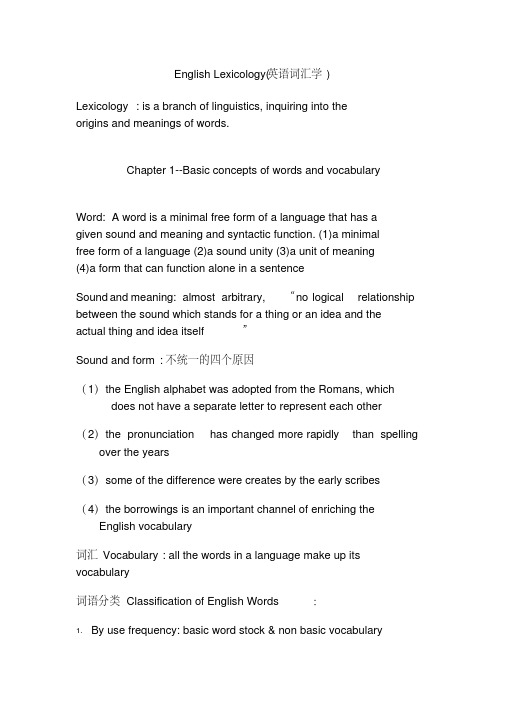
English Lexicology(英语词汇学)Lexicology: is a branch of linguistics, inquiring into theorigins and meanings of words.Chapter 1--Basic concepts of words and vocabularyWord: A word is a minimal free form of a language that has agiven sound and meaning and syntactic function. (1)a minimalfree form of a language (2)a sound unity (3)a unit of meaning(4)a form that can function alone in a sentenceSound and meaning: almost arbitrary, “no logical relationship between the sound which stands for a thing or an idea and theactual thing and idea itself”Sound and form:不统一的四个原因(1)the English alphabet was adopted from the Romans, which does not have a separate letter to represent each other(2)the pronunciation has changed more rapidly than spelling over the years(3)some of the difference were creates by the early scribes(4)the borrowings is an important channel of enriching the English vocabulary词汇Vocabulary: all the words in a language make up its vocabulary词语分类Classification of English Words:1.By use frequency: basic word stock & non basic vocabulary基本词汇的特征:1)All-National character(全民通用性most important)2)Stability3)Productivity(多产性) 4)Polysemy(多义性)5)Collocability(可搭配性)没有上述特征的词:(1)Terminology(术语) (2)Jargon(行话)(3)slang(俚语)(4)Argot(暗语)(5)Dialectal words (6)Archaisms(古语) (7) Neologisms(新词语):Neologisms2.By notion: content words实词 & functional words虚词3.By origin: native words & borrowed wordsNative words(本族语词): Two other features:(1)neutral instyle (2)frequent in useBorrowed words/Loan words: words taken over from foreign languages.(80% of modern EV)1) denizens(同化词,融入英语): (shirt from skyrta(ON))2) aliens(非同化词/外来词,可以看出源头): kowtow3) translation loans(译借词):按其他语言方式组成英语long time no see / tofu4) semantic loans(借义词):they are not borrowed withreference to the form,but their meanings are borrowedpioneer本指开拓者,先引申为先锋。
英语词汇学知识点归纳
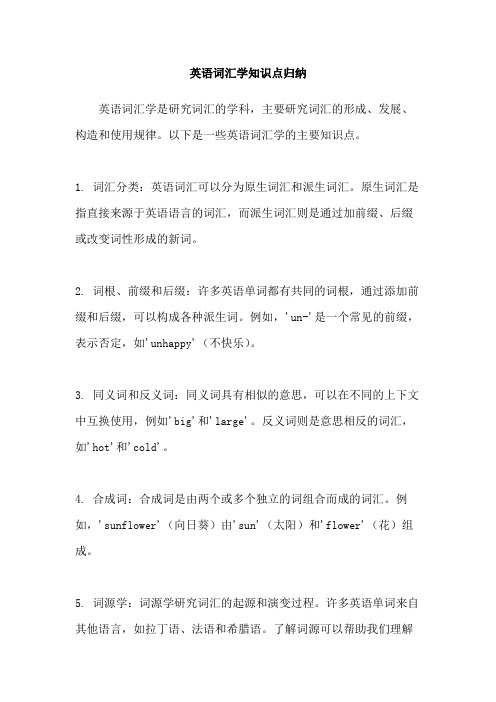
英语词汇学知识点归纳英语词汇学是研究词汇的学科,主要研究词汇的形成、发展、构造和使用规律。
以下是一些英语词汇学的主要知识点。
1. 词汇分类:英语词汇可以分为原生词汇和派生词汇。
原生词汇是指直接来源于英语语言的词汇,而派生词汇则是通过加前缀、后缀或改变词性形成的新词。
2. 词根、前缀和后缀:许多英语单词都有共同的词根,通过添加前缀和后缀,可以构成各种派生词。
例如,'un-'是一个常见的前缀,表示否定,如'unhappy'(不快乐)。
3. 同义词和反义词:同义词具有相似的意思,可以在不同的上下文中互换使用,例如'big'和'large'。
反义词则是意思相反的词汇,如'hot'和'cold'。
4. 合成词:合成词是由两个或多个独立的词组合而成的词汇。
例如,'sunflower'(向日葵)由'sun'(太阳)和'flower'(花)组成。
5. 词源学:词源学研究词汇的起源和演变过程。
许多英语单词来自其他语言,如拉丁语、法语和希腊语。
了解词源可以帮助我们理解词汇的含义和用法。
6. 词义的变化:词汇的意义会随时间和语境的变化而变化。
一些词汇可能会产生新的意义或失去原有的意义。
例如,'mouse'(老鼠)最初是指一种小动物,现在也可以指计算机的输入设备。
7. 词汇的语法功能:词汇在句子中扮演不同的语法角色,如名词、动词、形容词等。
了解词汇的语法功能可以帮助我们正确使用它们。
8. 语义关系:词汇之间存在各种语义关系,如同义关系、反义关系、上下位关系等。
了解这些关系可以帮助我们扩展词汇量,提高语言表达能力。
9. 词汇的习得和记忆:习得和记忆词汇是学习英语的重要一部分。
采用合适的记忆方法,如使用词汇卡片、词汇表等,可以帮助我们更好地掌握词汇。
以上是英语词汇学的一些主要知识点。
英语词汇学复习
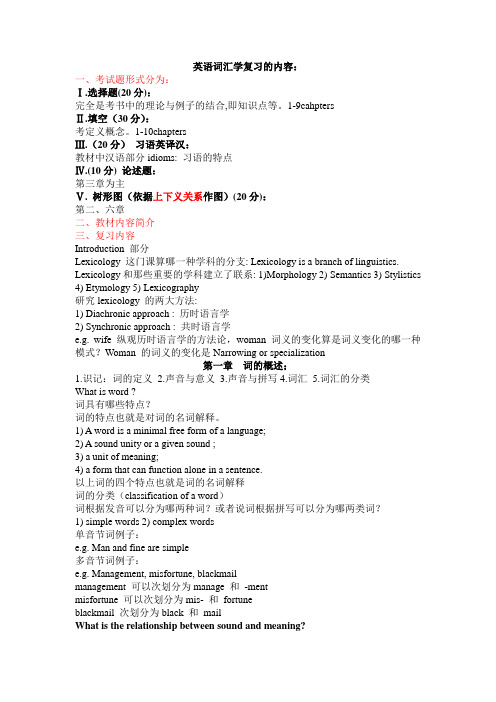
英语词汇学复习的内容:一、考试题形式分为:Ⅰ.选择题(20分):完全是考书中的理论与例子的结合,即知识点等。
1-9cahptersⅡ.填空(30分):考定义概念。
1-10chaptersⅢ.(20分)习语英译汉:教材中汉语部分idioms: 习语的特点Ⅳ.(10分) 论述题:第三章为主Ⅴ. 树形图(依据上下义关系作图)(20分):第二、六章二、教材内容简介三、复习内容Introduction 部分Lexicology 这门课算哪一种学科的分支: Lexicology is a branch of linguistics. Lexicology和那些重要的学科建立了联系: 1)Morphology 2) Semantics 3) Stylistics 4) Etymology 5) Lexicography研究lexicology 的两大方法:1) Diachronic approach : 历时语言学2) Synchronic approach : 共时语言学e.g. wife 纵观历时语言学的方法论,woman 词义的变化算是词义变化的哪一种模式?Woman 的词义的变化是Narrowing or specialization第一章词的概述;1.识记:词的定义2.声音与意义3.声音与拼写4.词汇5.词汇的分类What is word ?词具有哪些特点?词的特点也就是对词的名词解释。
1) A word is a minimal free form of a language;2) A sound unity or a given sound ;3) a unit of meaning;4) a form that can function alone in a sentence.以上词的四个特点也就是词的名词解释词的分类(classification of a word)词根据发音可以分为哪两种词?或者说词根据拼写可以分为哪两类词?1) simple words 2) complex words单音节词例子:e.g. Man and fine are simple多音节词例子:e.g. Management, misfortune, blackmailmanagement 可以次划分为manage 和-mentmisfortune 可以次划分为mis- 和fortuneblackmail 次划分为black 和mailWhat is the relationship between sound and meaning?1)There is …no logical relationship between the sound and actual thing.e.g. dog. cat2)The relationship between them is conventional.3) In different languages the same concept can be represented by different sounds. What is relationship between sound and form?1)The written form of a natural language is the written record of the oral form. Naturally the written form should agree with the oral form, such as English language.2)This is fairly true of English in its earliest stage i.e. Old English3)With the development of the language, more and more differences occur between the two.What are the great changes that causes illogical relationship or irregularity between sound and form?1) The internal reason for this is that the English alphabet was adopted from the Romans, which does not have a separate letter to represent each sound in the language so that some letters must do double duty or work together in combination.2) Another reason is that the pronunciation has changed more rapidly than spelling over the years, and in some cases the two have drawn far apart.3) A third reason is that some of the differences were created by the early scribes.4) Finally comes the borrowing, which is an important channel of enriching the English vocabulary.要记住以上四句话中的关键词:1) influenced by Romans2) Pronunciation changed3) early scribes4) borrowing你能不能举出外来语对英语发音,拼写造成不一致的例子有哪些?e.g. stimulus (L) ,fiesta (Sp) ,eureka (Gr), kimono (Jap)外来语对英语造成的最大的影响就是‘sound and form ’不一致。
英语词汇学知识点归纳
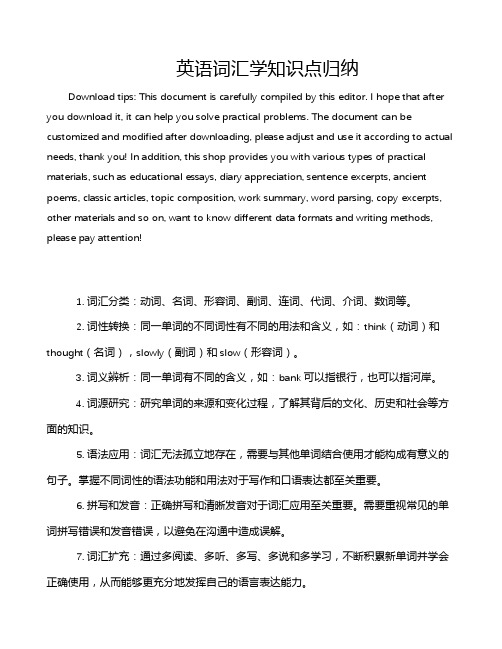
英语词汇学知识点归纳Download tips: This document is carefully compiled by this editor. I hope that after you download it, it can help you solve practical problems. The document can be customized and modified after downloading, please adjust and use it according to actual needs, thank you! In addition, this shop provides you with various types of practical materials, such as educational essays, diary appreciation, sentence excerpts, ancient poems, classic articles, topic composition, work summary, word parsing, copy excerpts, other materials and so on, want to know different data formats and writing methods, please pay attention!1. 词汇分类:动词、名词、形容词、副词、连词、代词、介词、数词等。
2. 词性转换:同一单词的不同词性有不同的用法和含义,如:think(动词)和thought(名词),slowly(副词)和slow(形容词)。
3. 词义辨析:同一单词有不同的含义,如:bank可以指银行,也可以指河岸。
4. 词源研究:研究单词的来源和变化过程,了解其背后的文化、历史和社会等方面的知识。
《英语词汇学》知识点归纳
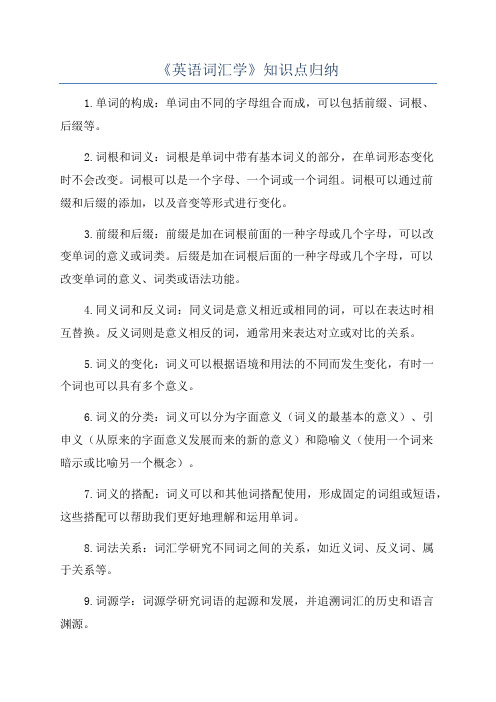
《英语词汇学》知识点归纳
1.单词的构成:单词由不同的字母组合而成,可以包括前缀、词根、
后缀等。
2.词根和词义:词根是单词中带有基本词义的部分,在单词形态变化
时不会改变。
词根可以是一个字母、一个词或一个词组。
词根可以通过前
缀和后缀的添加,以及音变等形式进行变化。
3.前缀和后缀:前缀是加在词根前面的一种字母或几个字母,可以改
变单词的意义或词类。
后缀是加在词根后面的一种字母或几个字母,可以
改变单词的意义、词类或语法功能。
4.同义词和反义词:同义词是意义相近或相同的词,可以在表达时相
互替换。
反义词则是意义相反的词,通常用来表达对立或对比的关系。
5.词义的变化:词义可以根据语境和用法的不同而发生变化,有时一
个词也可以具有多个意义。
6.词义的分类:词义可以分为字面意义(词义的最基本的意义)、引
申义(从原来的字面意义发展而来的新的意义)和隐喻义(使用一个词来
暗示或比喻另一个概念)。
7.词义的搭配:词义可以和其他词搭配使用,形成固定的词组或短语,这些搭配可以帮助我们更好地理解和运用单词。
8.词法关系:词汇学研究不同词之间的关系,如近义词、反义词、属
于关系等。
9.词源学:词源学研究词语的起源和发展,并追溯词汇的历史和语言
渊源。
10.词汇扩充:词汇学研究如何通过学习和运用词汇扩充词汇量,如学习词根、前缀和后缀的意义和用法,以及拆解和分析复杂单词的方法。
英语词汇学的英语总结

英语词汇学的英语总结引言英语词汇学是研究英语中单词和词汇的学科。
掌握英语词汇学的基本知识对于学习和运用英语语言至关重要。
本文将总结英语词汇学的核心概念和常见术语。
一、词汇和单词1. 词汇 (Vocabulary)词汇指的是某一语言中的所有单词的集合。
英语词汇是指英语语言中的全部词汇。
2. 单词 (Word)单词是构成语言的基本单位,它可以独立地表达一个完整的意思。
英语语言中包含了大量的单词。
3. 词根 (Root)词根是构成词汇的基本组成部分,它是一个单词的核心部分,具有某种基本的意思。
4. 词缀 (Affix)词缀是用来改变或加强单词意思的字母或字母组合,可以加在词根前面或后面。
5. 同义词 (Synonym)同义词是指在意义上或用法上与另一个单词相同或相近的单词。
二、单词的构成1. 基本词 (Base Word)基本词是不含有词缀的词,即单词的最基本形式。
2. 派生词 (Derived Word)派生词是通过在基本词上加上前缀或后缀而产生的新单词。
3. 复合词 (Compound Word)复合词是由两个或多个单词组合而成的新单词。
4. 缩略词 (Abbreviation)缩略词是将一个长的词或短语简化的方式,通常是取其首字母或字母组合作为缩写形式。
三、词义和词类1. 词义 (Meaning)词义指的是单词所表达的具体意义或概念。
2. 词类 (Word Class/Part of Speech)词类是指单词在语法上的分类,包括名词、动词、形容词、副词、介词、连词和代词等。
3. 同源词 (Cognate Word)同源词是指来自于同一个词根的单词,它们在不同语言中可能有相似或相同的形式和意义。
4. 多义词 (Polysemous Word)多义词是指具有两个或以上不同的意思的单词。
四、词汇的学习与记忆1. 词汇量 (Vocabulary Size)词汇量是指一个人掌握的单词数量,是评估一个人语言水平的重要指标。
英语词汇学知识点归纳详细
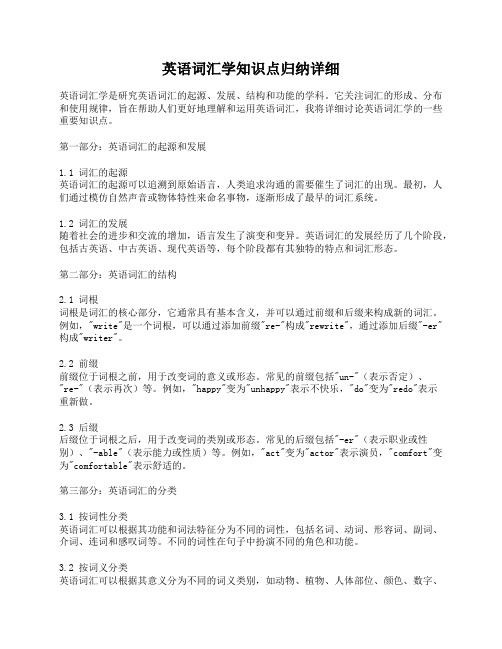
英语词汇学知识点归纳详细英语词汇学是研究英语词汇的起源、发展、结构和功能的学科。
它关注词汇的形成、分布和使用规律,旨在帮助人们更好地理解和运用英语词汇,我将详细讨论英语词汇学的一些重要知识点。
第一部分:英语词汇的起源和发展1.1 词汇的起源英语词汇的起源可以追溯到原始语言,人类追求沟通的需要催生了词汇的出现。
最初,人们通过模仿自然声音或物体特性来命名事物,逐渐形成了最早的词汇系统。
1.2 词汇的发展随着社会的进步和交流的增加,语言发生了演变和变异。
英语词汇的发展经历了几个阶段,包括古英语、中古英语、现代英语等,每个阶段都有其独特的特点和词汇形态。
第二部分:英语词汇的结构2.1 词根词根是词汇的核心部分,它通常具有基本含义,并可以通过前缀和后缀来构成新的词汇。
例如,"write"是一个词根,可以通过添加前缀"re-"构成"rewrite",通过添加后缀"-er"构成"writer"。
2.2 前缀前缀位于词根之前,用于改变词的意义或形态。
常见的前缀包括"un-"(表示否定)、"re-"(表示再次)等。
例如,"happy"变为"unhappy"表示不快乐,"do"变为"redo"表示重新做。
2.3 后缀后缀位于词根之后,用于改变词的类别或形态。
常见的后缀包括"-er"(表示职业或性别)、"-able"(表示能力或性质)等。
例如,"act"变为"actor"表示演员,"comfort"变为"comfortable"表示舒适的。
第三部分:英语词汇的分类3.1 按词性分类英语词汇可以根据其功能和词法特征分为不同的词性,包括名词、动词、形容词、副词、介词、连词和感叹词等。
词汇学期末复习各章知识点
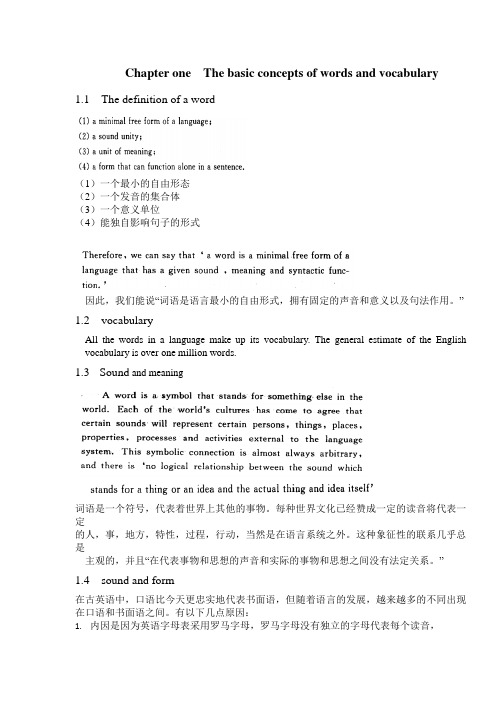
Chapter one The basic concepts of words and vocabulary1.1 The definition of a word(1)一个最小的自由形态(2)一个发音的集合体(3)一个意义单位(4)能独自影响句子的形式因此,我们能说“词语是语言最小的自由形式,拥有固定的声音和意义以及句法作用。
”1.2 vocabularyAll the words in a language make up its vocabulary. The general estimate of the English vocabulary is over one million words.1.3Sound and meaning词语是一个符号,代表着世界上其他的事物。
每种世界文化已经赞成一定的读音将代表一定的人,事,地方,特性,过程,行动,当然是在语言系统之外。
这种象征性的联系几乎总是主观的,并且“在代表事物和思想的声音和实际的事物和思想之间没有法定关系。
”1.4 sound and form在古英语中,口语比今天更忠实地代表书面语,但随着语言的发展,越来越多的不同出现在口语和书面语之间。
有以下几点原因:1.内因是因为英语字母表采用罗马字母,罗马字母没有独立的字母代表每个读音,因此一些字母代表两个读音或者组合在一起发音。
2.另一个原因是发音比拼写的变化快,在一些时候还拉开了距离。
在最近五百年里,尽管口语发音已经出现了显著的变化,却没有相应的拼写变化。
Another reason for this is that the pronunciation has changed more rapidly than spelling over the years, and in some cases the two have drawn far apart.3.第三个原因是一些早期的书写员发明了一些不同Those scribes had made some change to the word spelling4.到1500年年末,印刷已经变得非常普及。
英语词汇学复习重点——5、7-12单元
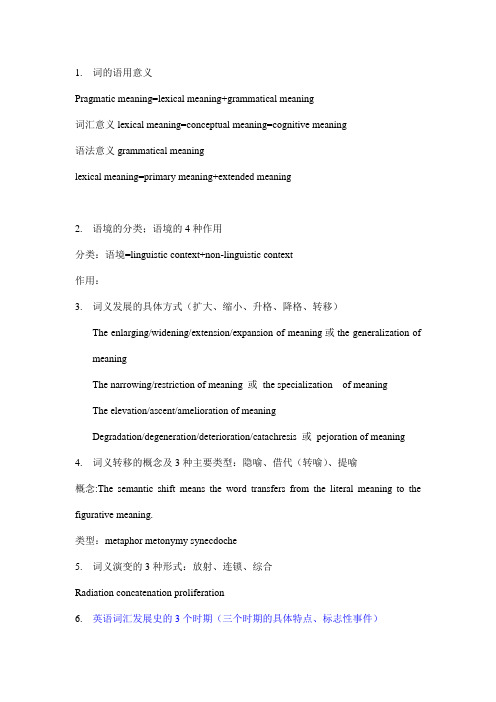
1.词的语用意义Pragmatic meaning=lexical meaning+grammatical meaning词汇意义lexical meaning=conceptual meaning=cognitive meaning语法意义grammatical meaninglexical meaning=primary meaning+extended meaning2.语境的分类;语境的4种作用分类:语境=linguistic context+non-linguistic context作用:3.词义发展的具体方式(扩大、缩小、升格、降格、转移)The enlarging/widening/extension/expansion of meaning或the generalization of meaningThe narrowing/restriction of meaning 或the specialization of meaningThe elevation/ascent/amelioration of meaningDegradation/degeneration/deterioration/catachresis 或pejoration of meaning 4.词义转移的概念及3种主要类型:隐喻、借代(转喻)、提喻概念:The semantic shift means the word transfers from the literal meaning to the figurative meaning.类型:metaphor metonymy synecdoche5.词义演变的3种形式:放射、连锁、综合Radiation concatenation proliferation6.英语词汇发展史的3个时期(三个时期的具体特点、标志性事件)The old EnglishThe middle EnglishThe modern English7.英语词汇的3种来源:本族语词、借词、新词Native words. loan/borrow words. Neologism8、新词的概念及4种产生方式(途径)新词(neologism&vogue words )A neologism is a recently coined word,phrase or usage.It can also be an existing word or phrase which has been assigned a new meaning.产生:1.构词法造词Word formation 2.借词borrowing 3.杜撰新词new coinage 4.语义转换semantic shift9、全世界使用英语国家的分类:ENL,ESL,EFLENL:English as a native languageESL:English as a second languageEFL:English as a foreign language10、美国英语词汇各发展阶段的特点(标志性事件)1.17世纪初到北美独立战争结束词美国在语言上的独立汇学家韦伯斯特美国独立战争后到内战占主导地位的仍然是英国英语美国内战后美国成为世界“盟主”对英语的影响不断扩大11、英语搭配的3种类别:固定型组合(成语/习语),自由型组合,习惯型搭配(能举例说明)固定型组合(fixed combination):see eye to eye(with)自由组合(free combination): see a film习惯型搭配(natural collocation): a cigar smoker12、搭配的4种理据语法(grammatical motivation)语用(pragmatic motivation)语义(semantic motivation)认知(cognitive motivation)13、英语成语的4个特点习用性:idiomaticity定型性:syntactic frozenness整体性:semantic nuity不透明性:semantic opacity14、英语成语的分类按句法分类:1.nominal idioms2.adjectival idioms3.verbal idioms 4.advertial idioms 5.sentence idioms最常见的按形式分类:1.比喻成语(figurative idioms)--隐喻成语(metaphorical idioms)明喻成语(similized idioms)2.谚语(proverbs)3.俚语(slang)。
英语词汇学知识点概括总结

英语词汇学知识点概括总结
一、英语词汇学概述
英语词汇学是语言学的一个重要分支,研究的是词汇的形成、构成、分类和运用规律等。
对于学习英语的人来说,词汇是基础,因此了解英语词汇学知识点对于提高语言水平很有
帮助。
二、英语词汇的分类
英语词汇根据不同的分类标准可以分为不同的类型,按照词性分类,英语词汇可以分为名词、动词、形容词、副词、代词、介词、连词和感叹词等。
此外,英语词汇还可以按照构
词法、语义分类和语法功能等不同标准进行分类。
三、英语词汇的构成
英语词汇的构成主要包括词根、前缀、后缀和词干等部分。
通过不同的组合方式,可以构
成不同的词汇,使得英语词汇系统更加丰富多样。
四、词汇记忆与运用
词汇是语言运用的基础,因此词汇的记忆和运用是英语学习中的重要内容。
学习者可以通
过生词本、词根词缀、语境记忆等方式进行词汇的记忆,同时要注重词汇的运用,积累语感,灵活运用词汇。
五、词汇拓展与应用
在学习英语词汇的过程中,不仅要记忆掌握基础词汇,还需要不断拓展词汇量,了解词汇
在不同语境下的应用,丰富自己的词汇库,使得语言表达更加流畅。
六、英语词汇学研究的意义
英语词汇学的研究对于语言学的发展具有重要的意义,可以帮助我们了解语言规律,促进
语言教学和翻译工作的发展,同时还可以为语言教学提供理论基础和实践指导。
总之,英语词汇学是语言学的重要分支之一,研究词汇的构成、分类和应用等方面,对于
提高语言水平和推动语言学科的发展都具有重要意义。
因此,我们可以在学习中加强对英
语词汇学知识的学习,从不同角度掌握词汇的规律和应用,提高语言表达能力和运用能力。
英语词汇学总结复习资料
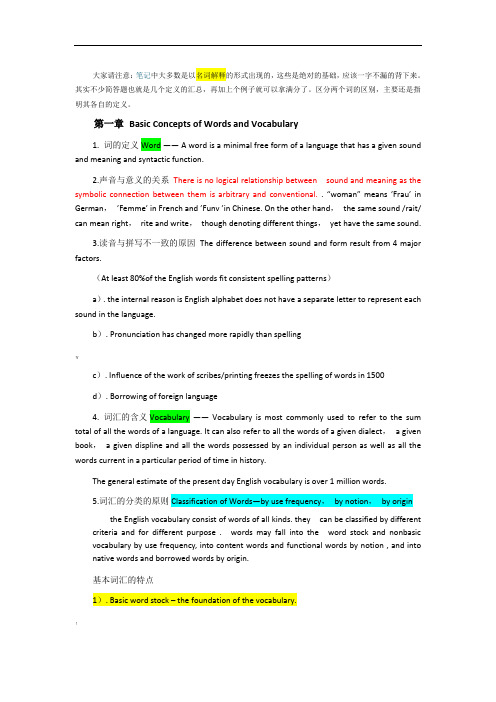
大家请注意:笔记中大多数是以名词解释的形式出现的,这些是绝对的基础,应该一字不漏的背下来。
其实不少简答题也就是几个定义的汇总,再加上个例子就可以拿满分了。
区分两个词的区别,主要还是指明其各自的定义。
第一章Basic Concepts of Words and Vocabulary1. 词的定义Word —— A word is a minimal free form of a language that has a given sound and meaning and syntactic function.2.声音与意义的关系There is no logical relationship between sound and meaning as the symbolic connection between them is arbitrary and conventional.. “woman” means ’Frau’ in German,’Femme’ in French and ’Funv ’in Chinese. On the other hand,the same sound /rait/ can mean right,rite and write,though denoting different things,yet have the same sound.3.读音与拼写不一致的原因The difference between sound and form result from 4 major factors.(At least 80%of the English words fit consistent spelling patterns)a). the internal reason is English alphabet does not have a separate letter to represent each sound in the language.b). Pronunciation has changed more rapidly than spelling¥c). Influence of the work of scribes/printing freezes the spelling of words in 1500d). Borrowing of foreign language4. 词汇的含义Vocabulary ——Vocabulary is most commonly used to refer to the sum total of all the words of a language. It can also refer to all the words of a given dialect,a given book,a given displine and all the words possessed by an individual person as well as all the words current in a particular period of time in history.The general estimate of the present day English vocabulary is over 1 million words.5.词汇的分类的原则Classification of Words—by use frequency,by notion,by originthe English vocabulary consist of words of all kinds. they can be classified by different criteria and for different purpose . words may fall into the word stock and nonbasic vocabulary by use frequency, into content words and functional words by notion , and into native words and borrowed words by origin.基本词汇的特点1). Basic word stock – the foundation of the vocabulary.!1.all national character (most important)– natural phenomenamost common things and phenomena of the human body and relationsworld around us names of plants and animals action,size,domain,state numerals,pronouns,prep. ,conj.2. stability– they donate the commonest thing necessary to life,they are like to remain unchanged. Only relative,some are undergoing some changes. But the change is slow.. arrow,bow,chariot,knight – past electricity,machine,car,plane —— now3.productivity– they are mostly root words or monosyllabic words,they can form new words with other roots and affixes.. foot – football,footage,footpath,footer4.polysemy – often possess more than one meaning. Become polysemous.¥. take to move or carry from one place to another to remove5.collocability– quite a number of set expressions,idiomatic usages,proverbial saying and others基本词汇在英语中的地位和重要性The basic word stock is the foundation of the vocabulary accumulated over centuries and forms the common core of the language .though words of the basic word stock constitute a small percentage of the English vocabulary ,yet it is the most important part of it .. heart – a change of heart, a heart of goldNon-basic vocabulary ——(例子)1. terminology –technical terms used in particular disciplines and academic areas as in medicinephotoscanning,hepatitis,indigestion,penicillin,algebra,trigonometry,calculus |2. jargon– specialized vocabulary in certain professions.Bottom line,ballpark figures,bargaining chips,hold him back,hold him in,paranoid3. slang—— substandard words often used in informal occasionsdough and bread,grass and pot,beaver,smoky,bear,catch,holler,Roger,X-rays,Certain words are labeled slang because of their usage.4. argot – words used by sub-cultured groupscan-opener,dip,persuader cant,jargon ,argot are associated with,or most available to,specific groups of the population.5. dialectal words– only by speakers of the dialect,beauty,chook,cocky,station,auld,build,coo,hame,lough,bog6. archaisms – words no longer in common use or restricted in use. In older poems,legal document and religious writing or speech.7. neologism– newly created words with new meaning . microelectronics,futurology,AIDS,internet,E-mailold meaning acquired new meaning . mouse,monitor2). Content word (notional word)– denote clear notions.Functional word (empty word,form word)– do not have notions of their own,express the relation between notions,words and sentences.a. Content words constitute the main body of the English vocabulary are numerous.Functional words are in a small number.)b. Content words are growing.Functional words remain stable.c. Functional words do far more work of expression than content words.3). Native words – are words brought to Britain in the 15 century by the German tribes. Ango-Saxon Words,50,000-60,000What is true of the basic word stock is also true of native world. More are1. neutral in style (not stylistical specific )2. in use (in academic fields and science French,Latin or Greek are used)(usage 70-90%)Borrowed words (loan words,borrowing)– words taken over from foreign language. 80%…本族语词在英语中的地位和重要性Native words form the mainstream of the basic word stock and stand at the core of the language .therefore , what is true of the basic word stock is also true of native words.According to the degree of assimilation and manner of borrowing,we can bring the loan words under 4 classes.– words borrowed early and now are well assimilated into English language.. port from portus(L)shift,change,shirt,pork cup from cuppa(L)– retained their original pronunciation and spelling. décor(F)blitzkreeg(G)emir,intermez,rowtow,bazaar,rajar,status quoloans–formed from the existing material in the English language but modeled on the patterns taken from another language.}1). Word translated according to the meaning. mother tough from lingua maternal(L)black humor from humor noir long time no see,surplus value,master piece2). Words translated according to the sound. kulak from kyrak(Russ)lama from lama(Tib)ketchup tea4. Semantic loans– their meaning are borrowed from another language. stupid old dump new sassy dream old joy and peace pioneer old explorer/person doing pioneering work new a member of the young pioneer fresh old impertinent,sassy,cheeky第二章The Development of the English1、Indo-European language family (Europe,the Near East,India)$It can be grouped into an Eastern set :Balto –Slavic 、Indo-Iranian、Armenian and Albanian; a Western set: Celtic、Italic 、Hellenic、GermanicIn the Eastern set , Armenian and Albanian are each the only modern language respectively,the Balto –Slavic comprises such modern language such as Prussian、Lithuanian、Polish、Czech、Bulgarian、Slovenian、Russian. In the Indo-Iranian we have Persian, Bengali, Hindi, Romany, the last three of which are derived from the dead language Sanskrit.In the Western set, Greek is the modern language derived from Hellenic. In the Celtic,we find Scottish, Irish,Welsh, Breton. the five Romance language ,namely, Portuguese,Spanish, French, Italian, Roumanian all belong to the Italic through an intermediate language called Latin. The Germanic family consist of the four Northern European language :Norwegian, Icelandic, Danish and Swedish, which are generally known as Scandinavian languages. Then there is German, Dutch, Flemish and English.2、History (时间,历史事件,特征)1)Old English (450-1150)totally 50,000-60,000 wordsThe 1st people known to inhabit England were Celts,the language was Celtic.The second language was the Latin of the Roman Legions. The Germanic tribes called angles,Saxons and Jutes and their language,Anglo-Saxon dominated and blotted out the Celtic. Now people refer to Anglo-Saxon as old English. At the end of 6th century,the introduction of Christianity has a great impact on the English vocabulary. The common practice was to create new words by combining two native words. In the 9th century,many Scandinavian words came into English. At least 900 words of Scandinavian are in modern English,our daily life and speech.特点:highly inflected languageBut the Norman Conquest started a continual flow of French words into English.}By the end of the 13th century,English gradually come back into public areas.Between 1250 and 150 about 9000 words of French origin pouered into English. 75% of them are till in use today.As many as 2500 words of Dutch origin come into English.特点:fewer inflections leveled ending3)Modern English (1500-up to now)early modern English (1500-1700)late modern English(1700-up to now)The Renaissance(the early period),Latin and Greek were recognized as the languages of the Western world’s great literary heritage.From the 1500’s through the 1700’s ,many writers experimented with words. Over 10000 new words entered the English language .many of these were taken from Latin and Greek .The Industrial Revolution was in the mid-17 century. With the growth of colonization,British tentacles began a stretching out of to every corner of the globe,thus enabling English to absorb words from all major languages of the world.·After World War II,many new words have been created to express new ideas,inventions and scientific achievements.More words are created by means of word-formation.thousands and thousands of new words have been entered to express new ideas inventions,and scientific achievements.more words are created by means of word-formation.in modern English,word endings were mostly lost with just a few exceptions English has evolved from a synthetic language to the present analytic language.science and technology terms make up about 45% of new words. words associated with life-style constitute of 24% and social and economic terms amount to over 10% .mention should be made of an opposite process of development . old words falling out if use.特点:ending are almost lost..3. Three main sources new words当代英语词汇发展的现状New words sweep in at a rate much faster than at any other historical period of time .词汇发展的主要原因1).The rapid development of modern science and technology2).Social: economic and political changes3).The influence of other cultures and languages4. Three modes of vocabulary development(英语发展的三个主要方式:创造新词、旧词新意、借用外来语词)1. Creation – the formation of new words by using the existing materials,namely roots,affixes and other elements. (This is the most important way of vocabulary expansion.)2. Semantic change - an old form which take on a new meaning to meet the new need.¥3. Borrowing –to take in words from other languages.(played a vital role in the development of vocabulary , particularly in earlier times)4. (Reviving archaic or obsolete)French 30%,Latin 8%,Japanese Italian 7%,Spanish 6%,German Greek 5%,Russian Yiddish 4%第三章Word Formation*1. Morpheme(词素) —— A morpheme is the smallest meaningful unit of a language. (The smallest functional unit in the composition of words.)*——A morpheme must be realized by discrete units. These actual spoken minimal carriers of meaning are morphs.words– morphemes are realized by single morphs.(词素变体)——Some morphemes are realized by more than one morph according to their position. Such alternative morphs are allomorphemes. . the morpheme of plurality (-s)has a number if allomorphemes in different sound context,. in cats/s/,in bags/z/,in matches/iz/.]5. Free morphemes or Free root —— The morphemes have complete meaning and van be used as free grammatical units in sentences,. cat,walk. They are identical with root words. morphemes which are independent of other morphemes are considered to be free.6.Bound Morphemes——The morphemes cannot occur as separate words. They are bound to other morphemes to form words,. recollection (re+collect+ion)collect –free morpheme re-and –ion are bound morphemes. (include bound root and affix)Bound morphemes are found in derived words.root —— A bound root is that part of the word that carries the fundamental meaning just like a free root. Unlike a free root,it is a bound form and has to combine with other morphemes to make words. Take -dict- for example:it conveys the meaning of “say or speak” as a Latin root,but not as a word. With the prefix pre-(=before)we obtain the verb predict meaning “tell beforehand”。
- 1、下载文档前请自行甄别文档内容的完整性,平台不提供额外的编辑、内容补充、找答案等附加服务。
- 2、"仅部分预览"的文档,不可在线预览部分如存在完整性等问题,可反馈申请退款(可完整预览的文档不适用该条件!)。
- 3、如文档侵犯您的权益,请联系客服反馈,我们会尽快为您处理(人工客服工作时间:9:00-18:30)。
大家请注意:中大多数是以名词解释的形式出现的,这些是绝对的基础,应该一字不漏的背下来。
其实不少简答题也就是几个定义的汇总,再加上个例子就可以拿满分了。
区分两个词的区别,主要还是指明其各自的定义。
第一章Basic Concepts of Words and Vocabulary 1. 词的定义Word —— A word is a minimal free form of a language that has a given sound and meaning and syntactic function. 2.声音与意义的关系There is no logical relationship between sound and meaning as the symbolic connection between them is arbitrary and conventional. E.g. “woman” means ’Frau’ in German,’Femme’ in French and ’Funv ’in Chinese. On the other hand,the same sound /rait/ can mean right,rite and write,though denoting different things,yet have the same sound. 3.读音与拼写不一致的原因The difference between sound and form result from 4 major factors. (At least 80%of the English words fit consistent spelling patterns) a). the internal reason is English alphabet does not have a separate letter to represent each sound in the language. b). Pronunciation has changed more rapidly than spelling c). Influence of the work of scribes/printing freezes the spelling of words in 1500 d). Borrowing of foreign language 4. 词汇的含义Vocabulary —— Vocabulary is most commonly used to refer to the sum total of all the words of a language. It can also refer to all the words of a given dialect,a given book,a given displine and all the words possessed by an individual person as well as all the words current in a particular period of time in history. The general estimate of the present day English vocabulary is over 1 million words.5.词汇的分类的原则Classification of Words—by use frequency,by notion,by originthe English vocabulary consist of words of all kinds. they can be classified by different criteria and for different purpose . words may fall into the word stock and nonbasic vocabulary by use frequency, into content words and functional words by notion , and into native words and borrowed words by origin.基本词汇的特点 1). Basic word stock – the foundation of the vocabulary. 1.all national character (most important)– natural phenomena most common things and phenomena of the human body and relations world around us names of plants and animals action,size,domain,state numerals,pronouns,prep. ,conj. 2. stability– they donate the commonest thing necessary to life,they are like to remain unchanged. Only relative,some are undergoing some changes. But the change is slow. e.g. arrow,bow,chariot,knight – past electricity,machine,car,plane —— now 3.productivity– they are mostly root words or monosyllabic words,they can form new words with other roots and affixes. e.g. foot – football,footage,footpath,footer 4.polysemy – often possess more than one meaning. Become polysemous. e.g. take to move or carry from one place to another to remove5.collocability– quite a number of set expressions,idiomatic usages,proverbial saying and others基本词汇在英语中的地位和重要性The basic word stock is the foundation of the vocabulary accumulated over centuries and forms the common core of the language .though words of the basic word stock constitute a small percentage of the English vocabulary ,yet it is the most important part of it . e.g. heart – a change of heart, a heart of gold Non-basic vocabulary ——(例子) 1. terminology – technical terms used in particular disciplines and academic areas as in medicine photoscanning,hepatitis,indigestion,penicillin,algebra,trigonometry,calculus 2. jargon – specialized vocabulary in certain professions. Bottom line,ballpark figures,bargaining chips,hold him back,hold him in,paranoid 3.slang—— substandard words often used in informal occasions dough and bread,grass and pot,beaver,smoky,bear,catch,holler,Roger,X-rays, Certain words are labeled slang because of their usage. 4. argot – words used by sub-cultured groups can-opener,dip,persuader cant,jargon ,argot are associated with,or most available to,specific groups of the population. 5. dialectal words – only by speakers of the dialect beauty,chook,cocky,station,auld,build,coo,hame,lough,bog 6. archaisms – words no longer in common use or restricted in use. In older poems,legal document and religious writing or speech. 7.neologism– newly created words with new meaning e.g. microelectronics,futurology,AIDS,internet,E-mail old meaning acquired new meaning e.g. mouse,monitor2). Content word (notional word)– denote clear notions. Functional word (empty word,form word)– do not have notions of their own,express the relation between notions,words and sentences. a. Content words constitute the main body of the English vocabulary are numerous. Functional words are in a small number. b. Content words are growing. Functional words remain stable. c. Functional words do far more work of expression than content words. 3). Native words – are words brought to Britain in the 15 century by the German tribes. Ango-Saxon Words,50,000-60,000 What is true of the basic word stock is also true of native world. More are 1. neutral in style (not stylistical specific ) 2. 2.frequent in use (in academic fields and science French,Latin or Greek are used)(usage 70-90%)Borrowed words (loan words,borrowing)– words taken over from foreign language. 80%本族语词在英语中的地位和重要性Native words form the mainstream of the basic word stock and stand at the core of the language .therefore , what is true of the basic word stock is also true of native words. According to the degree of assimilation and manner of borrowing,we can bring the loan words under 4 classes. 1.Denizen s – words borrowed early and now are well assimilated into English language. e.g. port from portus(L)shift,change,shirt,pork cup from cuppa(L) 2.Aliens – retained their original pronunciation and spelling e.g. décor(F)blitzkreeg(G)emir,intermez,rowtow,bazaar,rajar,status quo 3.translation loans– formed from the existing material in the English language but modeled on the patterns taken from another language. 1). Word translated according to the meaning e.g. mother tough from lingua maternal(L) black humor from humor noir long time no see,surplus value,master piece 2). Words translated according to the sound e.g. kulak from kyrak(Russ) lama from lama(Tib) ketchup tea 4. Semantic loans– their meaning are borrowed from another language e.g. stupid old dump new sassy dream old joy and peace pioneer old explorer/person doing pioneering work new a member of the young pioneer fresh old impertinent,sassy,cheeky 第二章The Development of the English 1、Indo-European language family (Europe,the Near East,India) It can be grouped into an Eastern set :Balto –Slavic 、Indo-Iranian、 Armenian and Albanian; a Western set: Celtic、Italic 、Hellenic、GermanicIn the Eastern set , Armenian and Albanian are each the only modern language respectively,the Balto –Slavic comprises such modern language such as Prussian、Lithuanian、Polish、Czech、Bulgarian、Slovenian、Russian. In the Indo-Iranian we have Persian, Bengali, Hindi, Romany, the last three of which are derived from the dead language Sanskrit.In the Western set, Greek is the modern language derived from Hellenic. In the Celtic,we find Scottish, Irish,Welsh, Breton. the five Romance language ,namely, Portuguese,Spanish, French, Italian, Roumanian all belong to the Italic through an intermediate language called Latin. The Germanic family consist of the four Northern European language :Norwegian, Icelandic, Danish and Swedish, which are generally known as Scandinavian languages. Then there is German, Dutch, Flemish and English.2、History (时间,历史事件,特征) 1)Old English (450-1150)totally 50,000-60,000 words The 1st people known to inhabit England were Celts,the language was Celtic. The second language was the Latin of the Roman Legions. The Germanic tribes called angles,Saxons and Jutes and their language,Anglo-Saxon dominated and blotted out the Celtic. Now people refer to Anglo-Saxon as old English. At the end of 6th century,the introduction of Christianity has a great impact on the English vocabulary. The common practice was to create new words by combining two native words. In the 9th century,many Scandinavian words came into English. At least 900 words of Scandinavian are in modern English,our daily life and speech. 特点:highly inflected language/// complex endings or vowel changes (full ending)2)Middle English (1150-1500)English,Latin,French Until 1066,although there were borrowings from Latin,the influence on English was mainly Germanic. But the Norman Conquest started a continual flow of French words into English. By the end of the 13th century,English gradually come back into public areas. Between 1250 and 150 about 9000 words of French origin pouered into English. 75% of them are till in use today. As many as 2500 words of Dutch origin come into English. 特点:fewer inflections leveled ending 3)Modern English (1500-up to now)early modern English (1500-1700) late modern English(1700-up to now)The Renaissance(the early period),Latin and Greek were recognized as the languages of the Western world’s great literary heritage.From the 1500’s through the 1700’s ,many writers experimented with words. Over 10000 new words entered the English language .many of these were taken from Latin and Greek . The Industrial Revolution was in the mid-17 century. With the growth of colonization,British tentacles began a stretching out of to every corner of the globe,thus enabling English to absorb words from all major languages of the world. After World War II,many new words have been created to express new ideas,inventions and scientific achievements. More words are created by means of word-formation. thousands and thousands of new words have been entered to express new ideas inventions,and scientific achievements. more words are created by means of word-formation. in modern English,word endings were mostly lost with just a few exceptions English has evolved from a synthetic language to the present analytic language. science and technology terms make up about 45% of new words. words associated with life-style constitute of 24% and social and economic terms amount to over 10% . mention should be made of an opposite process of development i.e. old words falling out if use. 特点:ending are almost lost.3. Three main sources new words当代英语词汇发展的现状New words sweep in at a rate much faster than at any other historical period of time .词汇发展的主要原因 1).The rapid development of modern science and technology 2).Social: economic and political changes 3).The influence of other cultures and languages 4. Three modes of vocabulary development(英语发展的三个主要方式:创造新词、旧词新意、借用外来语词) 1. Creation – the formation of new words by using the existing materials,namely roots,affixes and other elements. (This is the most important way of vocabulary expansion.) 2. Semantic change - an old form which take on a new meaning to meet the new need. 3. Borrowing – to take in words from other languages.(played a vital role in the development of vocabulary , particularly in earlier times) 4. (Reviving archaic or obsolete) French 30%,Latin 8%,Japanese Italian 7%,Spanish 6%,German Greek 5%,Russian Yiddish 4% 第三章Word Formation *1. Morpheme(词素) —— A morpheme is the smallest meaningful unit of a language. (The smallest functional unit in the composition of words.) *2.Morph—— A morpheme must be realized by discrete units. These actual spoken minimal carriers of meaning are morphs. 3.Monomorphenic words– morphemes are realized by single morphs. 4.Allomorph(词素变体)——Some morphemes are realized by more than one morph according to their position. Such alternative morphsare allomorphemes. E.g. the morpheme of plurality (-s)has a number if allomorphemes in different sound context, e.g. in cats/s/,in bags/z/,in matches/iz/. 5. Free morphemes or Free root —— The morphemes have complete meaning and van be used as free grammatical units in sentences,e.g. cat,walk. They are identical with root words. morphemes which are independent of other morphemes are considered to be free. 6.Bound Morphemes—— The morphemes cannot occur as separate words. They are bound to other morphemes to form words,e.g. recollection (re+collect+ion)collect – free morpheme re-and –ion are bound morphemes. (include bound root and affix)Bound morphemes are found in derived words. 7.Bound root —— A bound root is that part of the word that carries the fundamental meaning just like a free root. Unlike a free root,it is a bound form and has to combine with other morphemes to make words. Take -dict- for example:it conveys the meaning of “say or speak”as a Latin root,but not as a word. With the prefix pre-(=before)we obtain the verb predict meaning “tell beforehand”。
